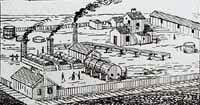| ||||||||||||
|
| ||||||||||||
 | Empire Oil Works, Rectory and Trafalgar, c. 1886, from Industries of Canada |
The discovery of oil in Lambton County, west of London, in the late 1850s had a direct impact on the development of East London. Likely because of the city's rail connections, its growing labour force and the presence of cheap land east of the city, many of the refineries processing Lambton County oil came to be located here. The first refineries appeared in the early 1860s, and by the end of the decade, over 50 acres were occupied by oil refining. The location was deemed ideal because of the proximity of the petroleum fields, low rail costs (railway tanker cars were introduced in 1865), and,  as East London was
still part of London Township, low taxes. By 1876, some 55 refineries were
in operation, but, with so much production in the London - Petrolia -
Windsor corridor and in Pennsylvania, the oil market was soon glutted and
prices plummeted from a peak of $1 per gallon to only 12¢. as East London was
still part of London Township, low taxes. By 1876, some 55 refineries were
in operation, but, with so much production in the London - Petrolia -
Windsor corridor and in Pennsylvania, the oil market was soon glutted and
prices plummeted from a peak of $1 per gallon to only 12¢.On April 30, 1880, William Spencer and Frederick A. Fitzgerald of the Victor Oil Works joined forces with Jacob Englehart and Isaac Guggenheim (a member of the famous New York family), the owners of the Silver Star Works, and 16 other refinery owners to form the Imperial Oil Company.  They hoped that by
sharing their resources, they could all share in the wealth. The Silver Star
facilities on Bathurst Street were retained and expanded to be the home of
the new Imperial Oil, and the remaining refineries were shut down. On July
11, 1883, the Imperial Oil refinery was struck by lightning and burnt to the
ground. Imperial rebuilt in Petrolia, and by 1885 had moved its
headquarters to that flourishing town. They hoped that by
sharing their resources, they could all share in the wealth. The Silver Star
facilities on Bathurst Street were retained and expanded to be the home of
the new Imperial Oil, and the remaining refineries were shut down. On July
11, 1883, the Imperial Oil refinery was struck by lightning and burnt to the
ground. Imperial rebuilt in Petrolia, and by 1885 had moved its
headquarters to that flourishing town.While several refineries stayed in operation, some as late as 1900, the oil boom had passed by the 1880s. Related industries carried on however and even expanded, including Canada Chemical which had made sulphuric acid for the refineries and the London and Petrolia Barrel works which also made beer and apple barrels. As well, the expansion of the railway system and growth of their repair and construction shops absorbed those left idle by the closing refineries. A key figure in the refinery industry was Herman Frasch, a chemist from Germany. It was Frasch, working for the London refiners, that discovered how to refine the southwest Ontario petroleum so that it wouldn't smell like sulphur when it was burning in the lamps. He went south following his time here and did the same for an American refiner who was having the same problem with the oil from his wells in Ohio. His name was John D. Rockefeller and his Standard Oil Company eventually bought Imperial. |
|

